Shared Legacy Farms Week 4 Newsletter (July 9-15, 2023)
Farm Newsletter Week 4
July 9-15, 2023 | “B” Week
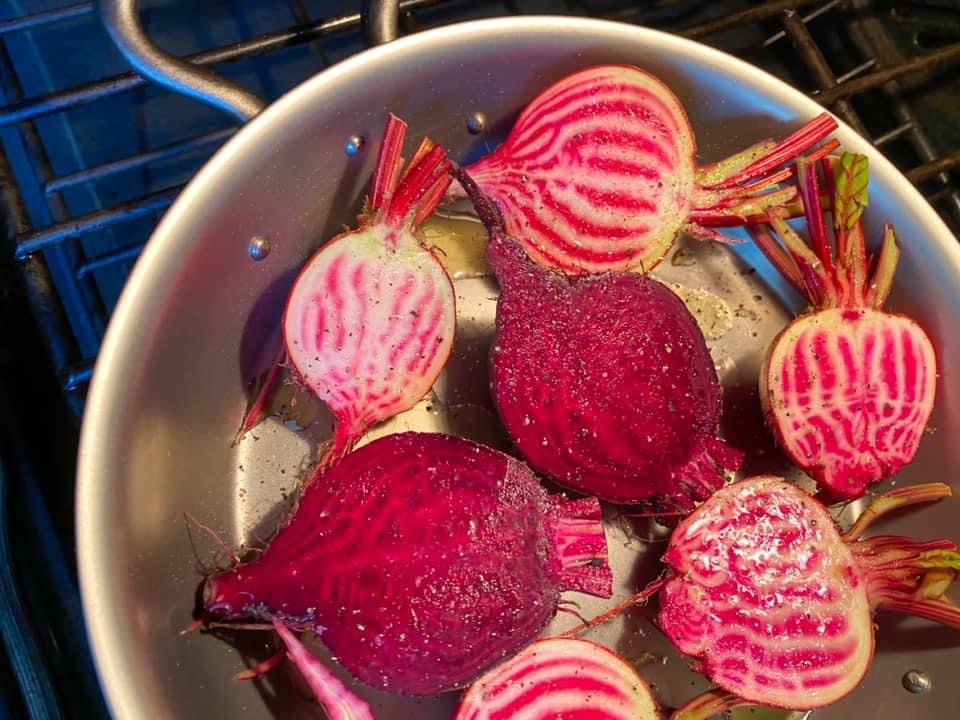
Chioggia beets are featured this week. They have a characteristic striping inside. Photo credit: Laurie Knueven
What’s in the Box this Week?
CHIOGGIA “BULLSEYE” BEETS ~ These beets will have a gorgeous interior when sliced raw — a “bullseye” target. I love to use these in raw preparations, as the bullseye effect will fade when cooked. To store: If your beets still have greens attached, cut them off, leaving an inch of stem. Store the beet roots, with the rootlets (or “tails”) attached, unwashed, in a plastic bag in the crisper bin of your refrigerator. They will keep for several weeks. To prep: Just before cooking, scrub beets well and remove any scraggly leaves and rootlets. If your recipe calls for raw beets, peel them with a knife or a veggie peeler, then grate or cut them according to the recipe. To remove the skins, you can roast them in foil or boil them, and the peels will slip right off. To freeze: Boil or bake beets until done. Cool them in ice water or let them come to room temperature. Remove peels. Trim the beets into 1/4 inch slices or keep them whole (if they are small). Place in Ziplock freezer bag and remove as much air as possible. Seal and freeze.
WHITE & GREEN KOHLRABI with tops (1 head of each color) ~This plant was developed by crossing a cabbage with a turnip! The edible part of the plant is an enlarged section of the stem that develops just above the ground. It has a crisp interior like a potato. Store kohlrabi globe and leaves separately. The bulb will last for 2 weeks refrigerated in a plastic bag. Wrap leaves and stalks in a plastic bag and keep in the crisper drawer of the refrigerator. To prep: Rinse under cold running water just before use. Cut the outer skin off with a knife. Trim off the remains of the stalks and root. Grate, slice, or chop as desired. To cook: Cut raw kohlrabi bulb into sticks for a refreshing addition to a raw vegetable tray or grate it for salads. Try raw kohlrabi smeared with peanut butter. Lightly boil, steam or bake it, or add it to stews and stir-fries. Young kohlrabi leaves can be used in recipes calling for greens. To freeze: Cut into cubes or slices and blanch for 3-4 minutes. Place into ice water bath to stop the cooking. Drain and dry. Place in Ziplock freezer bag.
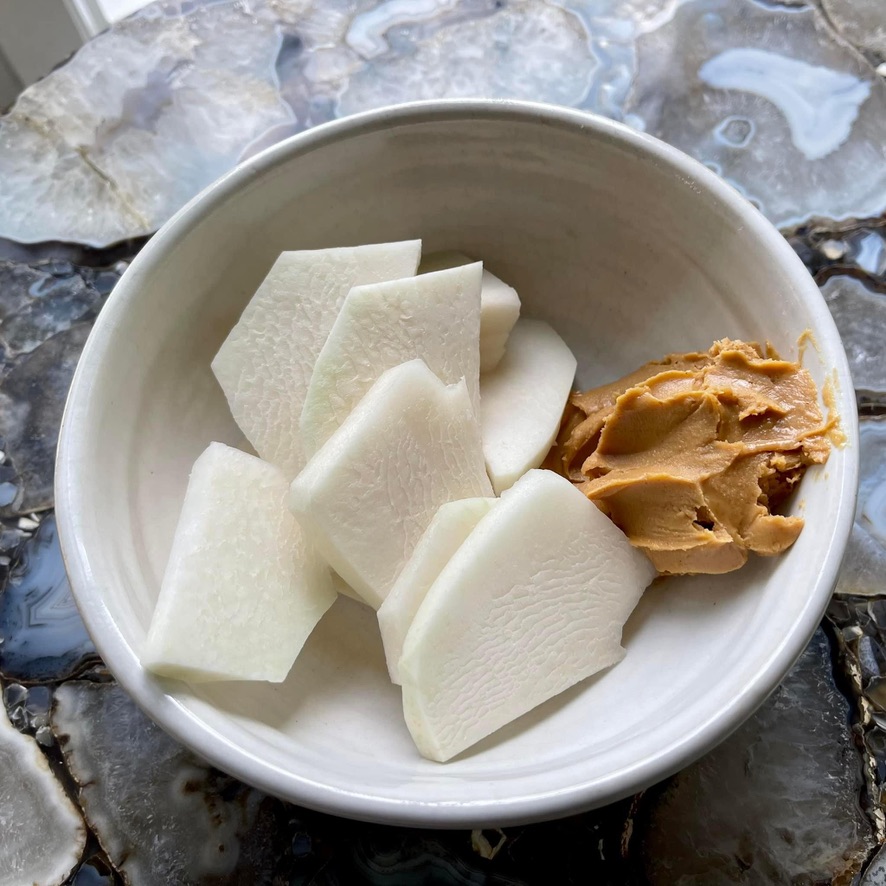
This is Farmer Kurt’s favorite way to eat kohlrabi. Raw with peanut butter. Try it!
WHITE SALAD TURNIPS with tops (1 bunch) ~ Turnips are a root vegetable, related to arugula and radishes, which are members of the mustard family. Large or old turnips can be unpleasantly “hot” if not cooked properly or combined with the proper vegetables (like potatoes), but younger turnips add great zip to dishes. They are best in the fall or spring, when they are small and sweet. To store: Remove the greens from the turnips and store in a plastic bag to use within 3 days. The turnip roots should be stored in a plastic bag in the crisper drawer of your fridge for up to a week. To prep: Cut off the green tops (which can be eaten as well). Wash and cut the white roots into wedges or slices. To cook: Serve raw with dip in a veggie tray. Or grate and add them to a salad. Turnips are delicious when roasted with other root vegetables (like carrot, potatoes, rutabaga, garlic). Add a turnip or two to your favorite mashed potato recipe. Or add them into soups and stews. To freeze roots: Blanch for 3 minutes in hot boiling water. Cool in ice water for 3 minutes, drain and pack into freezer containers or freezer bags.
BUNCHED PARSLEY (1 bunch) ~ For short-term storage, stand upright in a container with an inch of water. Then cover the herbs loosely with a plastic bag and refrigerate for up to 2 weeks. To prep: Chop the leaves and stem before cooking. The stem can be used to flavor soups and stews too. To dry: Place a piece of paper towel on a glass plate. Layer the parsley evenly around the plate being sure not to overlap. Cover with another piece of paper towel. Microwave on high for 1 minute. Leaves will be dry. Crinkle them with your finger and place them in a dry container, such as a Mason jar with a lid. To freeze: Chop parsley finely and freeze in ice cube trays with water. Pop out frozen cubes and freeze in a freezer bag.
LONG RED TROPEA ONIONS (1 bunch) ~ These onions are often called “torpedoes” at our farm, due to their torpedo-like shape. Because they are not cured, these fresh onions will need to be stored in a plastic bag in the fridge and use within 2 weeks. To prep: Peel the onion’s skin and cut off the roots and top. To freeze: Cut or slice onions to desired size and place in freezer Ziplock bag. Remove all the air and seal. It helps to freeze them in 2-3 cup increments.
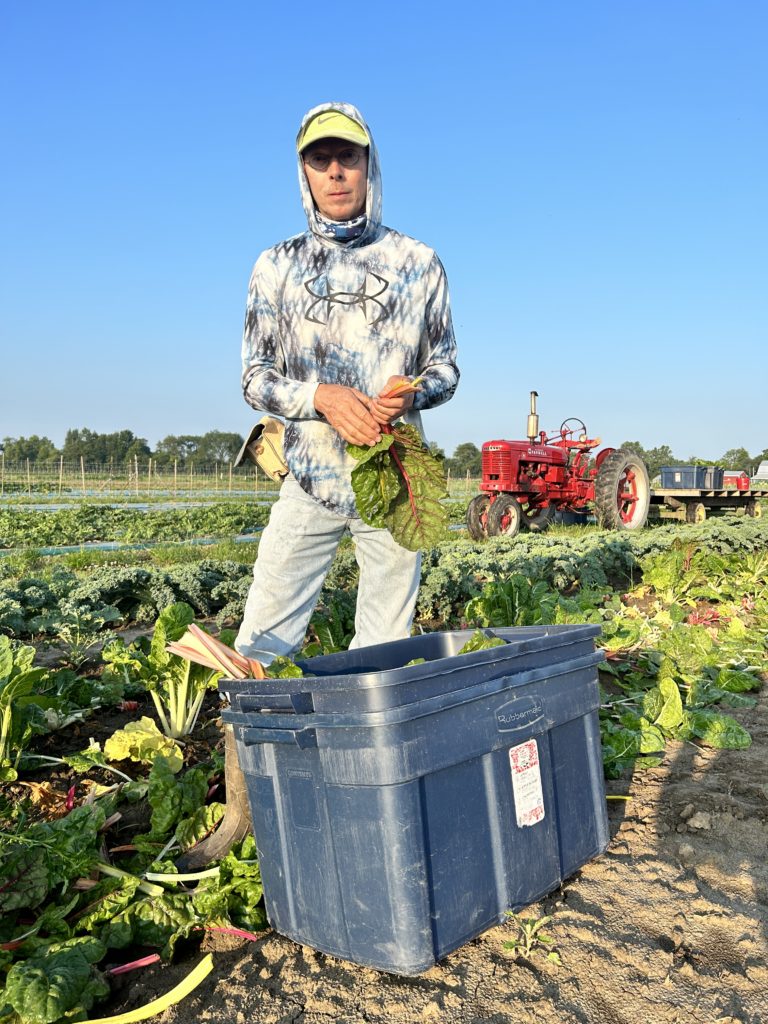
John Sawvel harvests chard last week. He’s also the person who discovered the fire and saved our garage from burning.
ARROWHEAD MINI CABBAGE (1 head) ~ To store: Place dry, unwashed cabbage heads in the refrigerator, preferably in the vegetable bin. Store for up to 3 months! To prep: Rinse the cabbage under cold water before use. Cut cabbage head in half. Be sure to remove the stem end and triangular core near the base. To use: Eat raw in salads, steamed, braised or fried. Turn raw cabbage into coleslaw or sauerkraut. Roast cabbage steaks/slices at 400 F drizzled with olive oil and salt. Or try stir-frying shredded cabbage in olive oil until wilted with a little bit of minced garlic. To freeze: Choose how to cut your heads based on your end use. Cook in boiling pot of water for 90 seconds. Douse in ice water to stop the cooking process. Drain the cabbage and dry as much as possible. Place in Ziplock freezer bags based on your portions you plan to use, and remove as much air as possible. Put in freezer.
BASIL (1 bunch) ~ To store: Basil is very sensitive to cold. Do not refrigerate fresh basil; it will turn black. Instead, strip the lower leaves off the stems and place stems in a glass of water on the kitchen counter like a flower. To prep: Mince well. Add to butter, cream cheese, or your favorite pasta sauce. Make a batch of pesto with pine nuts, Parmesan, olive oil, salt, and garlic. To dehydrate: Remove leaves from stem and place on a piece of paper towel on a glass plate. Cover with another piece of paper towel. Microwave plate on high for 1 minute. Leaves will be dry. Crinkle them with your finger and place them in a dry container, such as a Mason jar with a lid. To freeze: Basil does not freeze well. Instead, make a batch of pesto and freeze it flat in Ziplock bags.
KALE SALAD MIX (10 oz) ~ This is more like “teenager” size — a bit bigger than you might get from the grocery store lettuce aisle. Four different varieties of kale are seeded together in a row to make a fun mix. You may notice that one of the varieties yellows faster than the others. Store unwashed lettuce in a Debbie Meyer Green bag or Tupperware FridgeSmart container in the refrigerator. To store lettuce that you have already washed and dried with a spinner, place back in a plastic bag with a dry paper towel in the bag, and place the package in the vegetable crisper bin. Use within 4 days. To prep: Wash leaves in a basin of cold water. Dry in a salad spinner. To freeze: Not recommended.
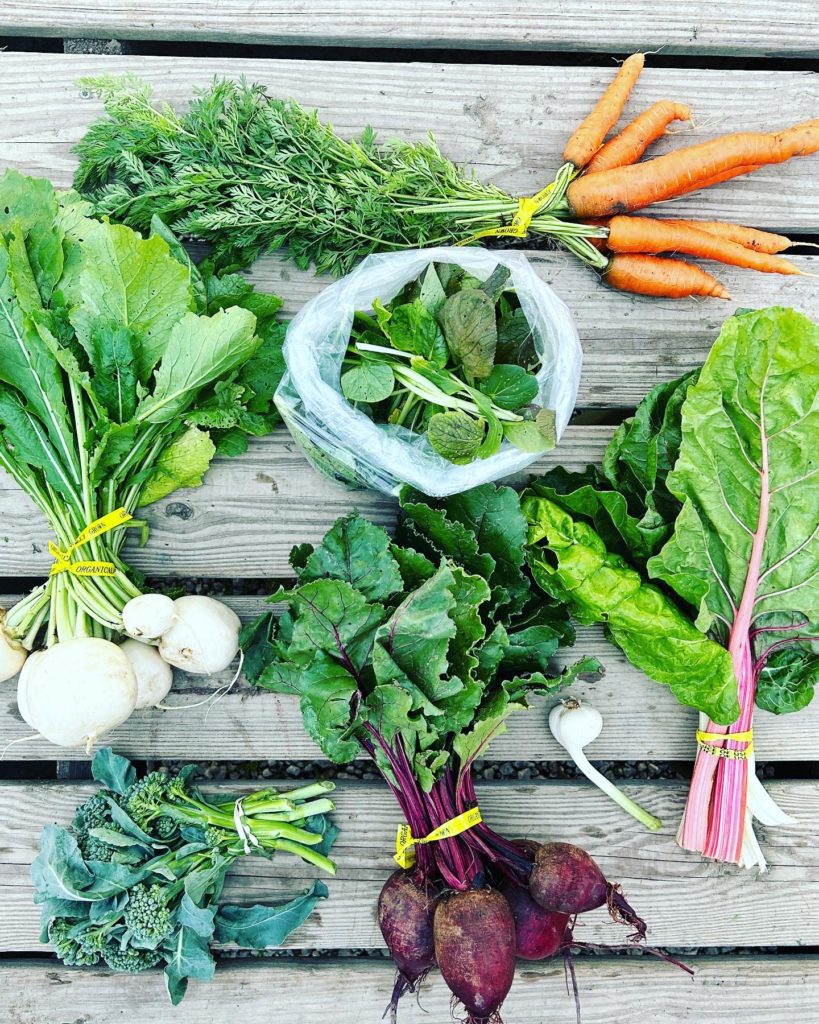
Last week’s veggie box was gorgeous!
WEEK #4 ADD-ON SHARES: We are Week “B”
Odd-numbered weeks of our CSA season (week 1,3,5) are called “A” weeks. And even-numbered weeks (week 2,4,6) are called “B” weeks. If you have any kind of non-veggie, bi-weekly share, you have been assigned to either “A” or “B” week for the season. If you get a cheese share, it always comes on Week “A.”
WEEK 4 FRUIT SHARE:
RHUBARB ~ (from Wayward Seed Farm, Fremont) This tart vegetable is one of the first to emerge in the spring. Because of its sour taste, sugar is usually added. It has the texture of celery and can be red or green. To store: Wrap in foil and place in the fridge. Use within a week. To prep: Remove the leaves and bottom inch of the stalk. Chop or mince. To use: Add to pies, cakes, muffins, scones, jello, or sauce. Try eating rhubarb raw as a snack, dipped in sugar! To freeze: Chop and pack into Ziplock freezer bags to flash freeze.
SWEET CHERRIES ~ (from Eshleman Orchards, Clyde, OH) Sweet cherries will be either a dark red color, or a red/yellow blush color (the Rainier cherry) and are best for eating out of hand. Sour cherries are usually a bit soft, and are best used in baking pies or cobblers. Store cherries in your refrigerator in a plastic, perforated bag in the crisper drawer for up to a week. To prep: Remove stem. Pit the cherries after washing. To freeze: Choose firm, ripe cherries. Pit cherries first (although you don’t have to). Flash freeze on a sheet pan. Then pop into a Ziplock bag. Freeze for up to a year.
BLUEBERRIES (PINT) ~ These are sourced from Michigan by Quarry Hill for us. To store: Store blueberries in the refrigerator for up to 5 days. Use a vinegar bath to kill off bacteria and lengthen their shelf life. To prep: Rinse gently just before using
CUSTOMER PHOTO OF THE WEEK!
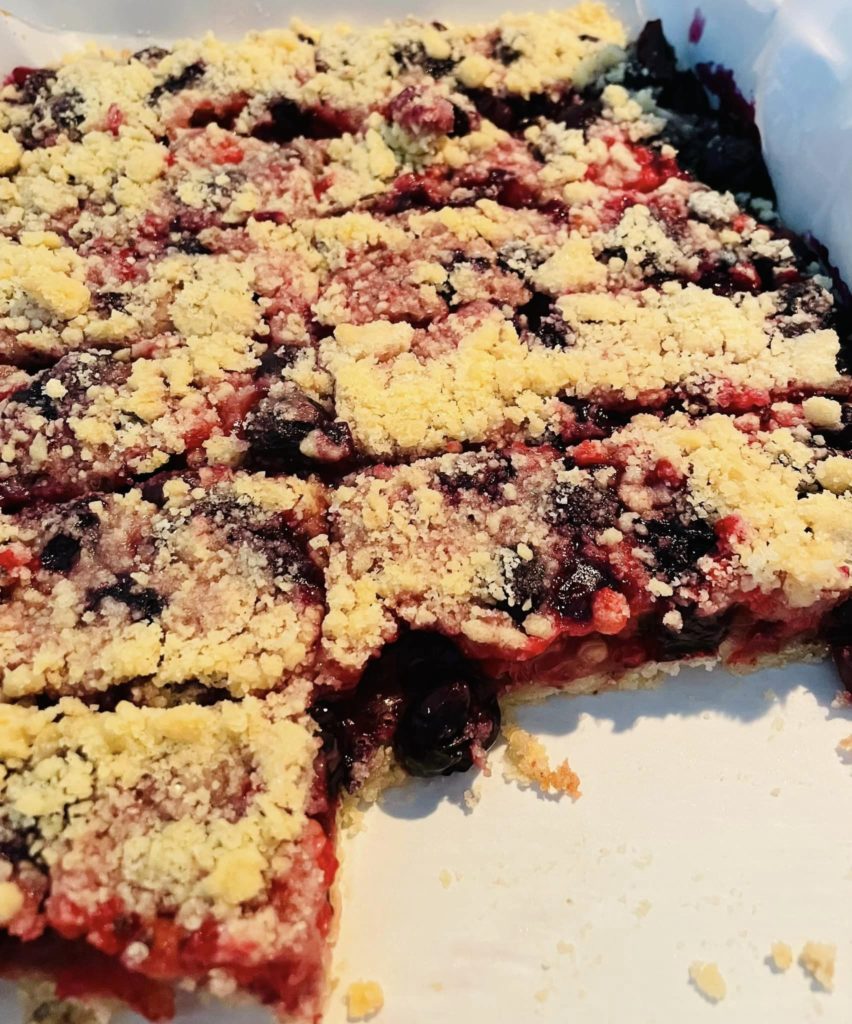
Vegan Pie Bar with red currants, cherries and blueberries from Melanie Forrey! Very July 4th! This post wins the Photo of the Week!
Ice Cream Flavor of the Week:
MANGO CHAMOY from Knueven Creamery. Note: be sure to stop and pick up your ice cream from the Knueven milk truck at your pickup site! They will be located either right before or after your veggie pickup. Your farmers will not be passing this out in their delivery line.
Coffee Flavor of the Week:
TANZANIA PEABERRY: Maddie & Bella Coffee Company ~ medium body, rich, and uncommonly fruity
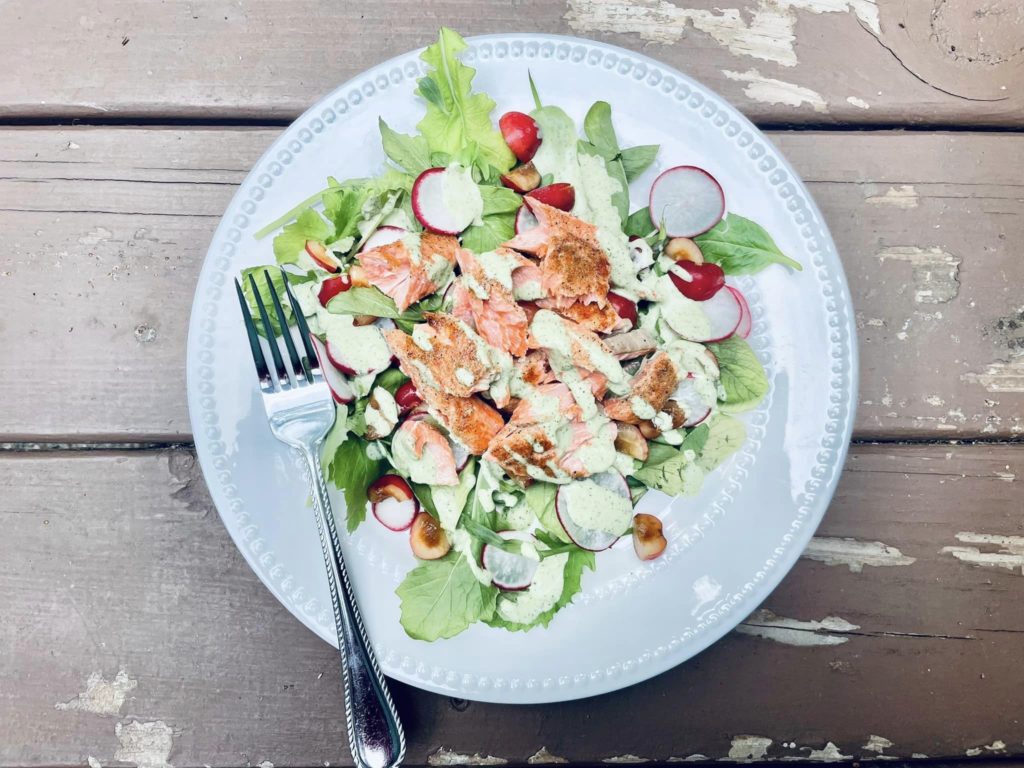
Photo Credit: Kate Lynn
FIELD TO TABLE PRIVATE DINNER ~ TICKETS NOW AVAILABLE
SAVE THE DATE: FIRST FIELD TO TABLE DINNER IS JULY 29
Chef Joseph from Cork and Knife Provisions will be leading TWO farm dinners for us this season — one small table event with only 20 guests, and the other will be a larger affair in the fall. The first dinner is scheduled for Saturday, July 29, at 6:00 PM, at the farm. You’ll get premier seating with a gorgeous view of the fields in the late summer months. Arrive early and stroll the acreage while sipping on your BYO alcoholic beverage of choice, or enjoy one of the chef’s signature mocktails. Farmers Kurt and Corinna will be in attendance so you can rub shoulders with them and learn some of our fun farm stories of years past. Dress is nice-casual. Be comfortable.
Seating will be limited to 20 for this first event. Price: $125.
You can view the menu here. This is a tapas style menu — with 7 mini courses that will feature some of SLF’s seasonal spread!
To snag one of the tickets, please pre-order and pay on Cork and Knife’s event page. Your farmers do earn a small commission from the ticket sales. Thank you!
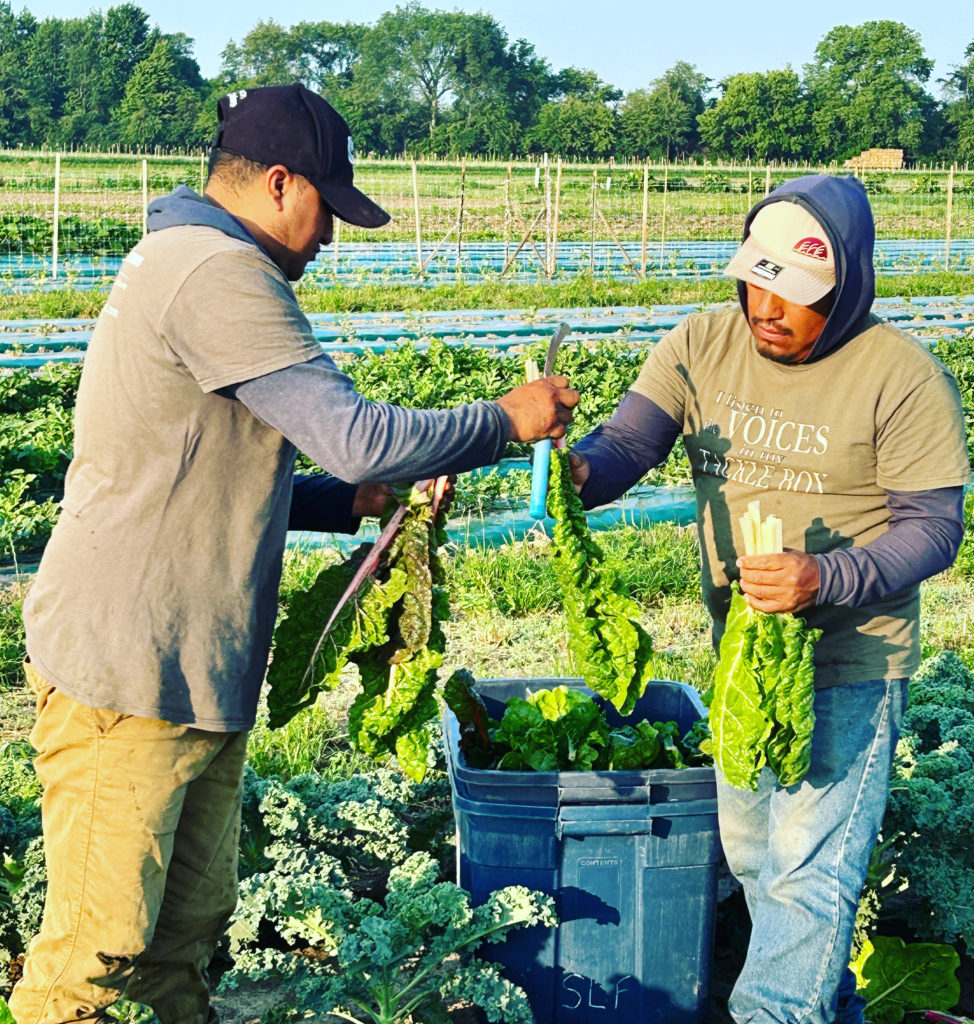
Pedro and Jose partner up to harvest and bunch Swiss chard for last week’s box.
FARMER KURT’S FIELD NOTES
It was HOT this week!
The summer squash is just starting to come on. The zucchini plants don’t look as good as the Zephyr variety (that’s the yellow squash with a lime-green tip). I actually need to harvest them today, to get the big pieces off, so more energy can go towards growing the new blossoms. I have a slight timing issue with my broccoli. I have 460 heads out there as of Friday afternoon. But they need to be harvested TODAY, and if I do so, I’m not sure they’ll hold until Thursday (when Perrysburg and Port Clinton CSA folks pick up). This is a dilemma I often face — do I harvest HALF of the crop and give it to the Tuesday CSA members, and leave out Thursdays folks? Or do I find another outlet? Or just cut my losses? We have a lot of jobs to do this weekend, and a pretty big CSA box already — so I may just count it as a loss, as I’m not sure it’s worth the cost of labor to harvest it all.
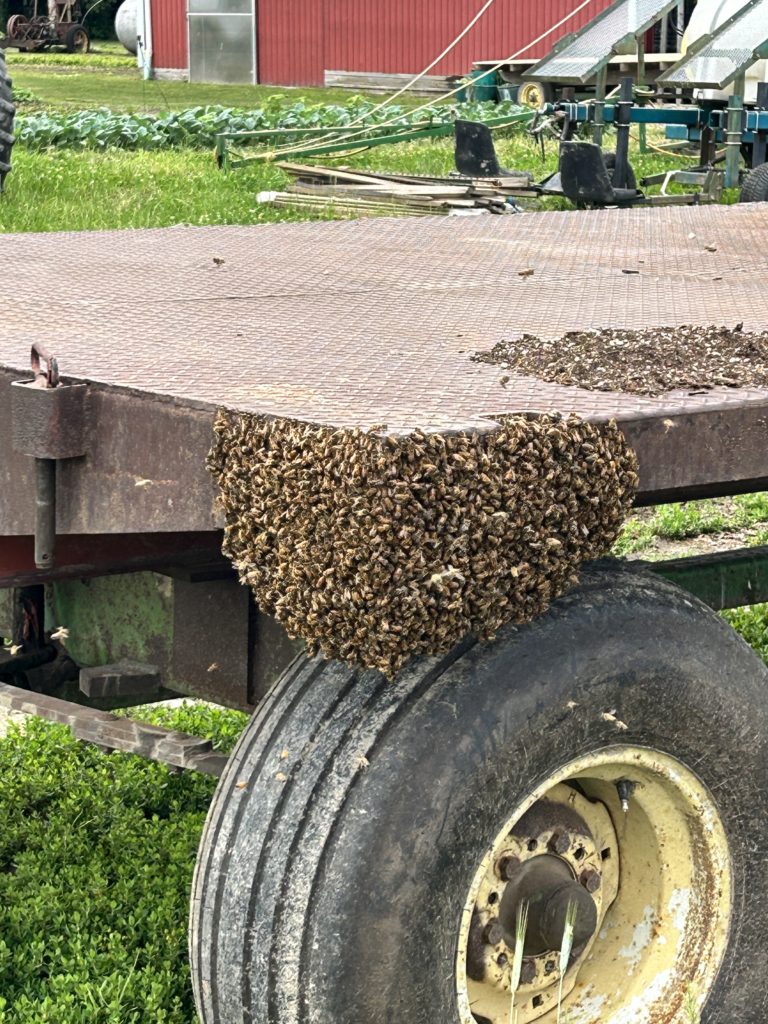
This is what a bee swarm looks like!
We had our first bee swarm at the farm. I was working with Josiah on moving a piece of equipment, and all of a sudden we saw a “tornado” of bees starting to form. It was a little freaky how fast it happened. More and more bees joined the swirl, and then settled on the edge of one of our wagons. There were so many that the colony started to look like it was “dripping” off the wagon. Watch the YouTube video short here.
I had my boys weed the peppers on Friday. They are some good workers! I usually do a major weeding between the pepper plants at least 3 times a year. They use a stirrup hoe to get the job done. Corinna came out to take pictures and texted me later… “Did you tell them to wear sunscreen?” Ah, that’s my wife.
The big job on the farm this week was mulching the cucumbers and summer squash with straw. This involves using about 3/4 of a wagon of straw bales (which came from the rye field). I have my crew spread it out in the pathways between the beds (not on the beds), to stop the weeds from growing. We broke it up into two days. Thursday it was HOT and muggy work – not fun for my team. Friday was a bit cooler. The straw can make your skin feel itchy, so I always tell my boys to wear long sleeves.
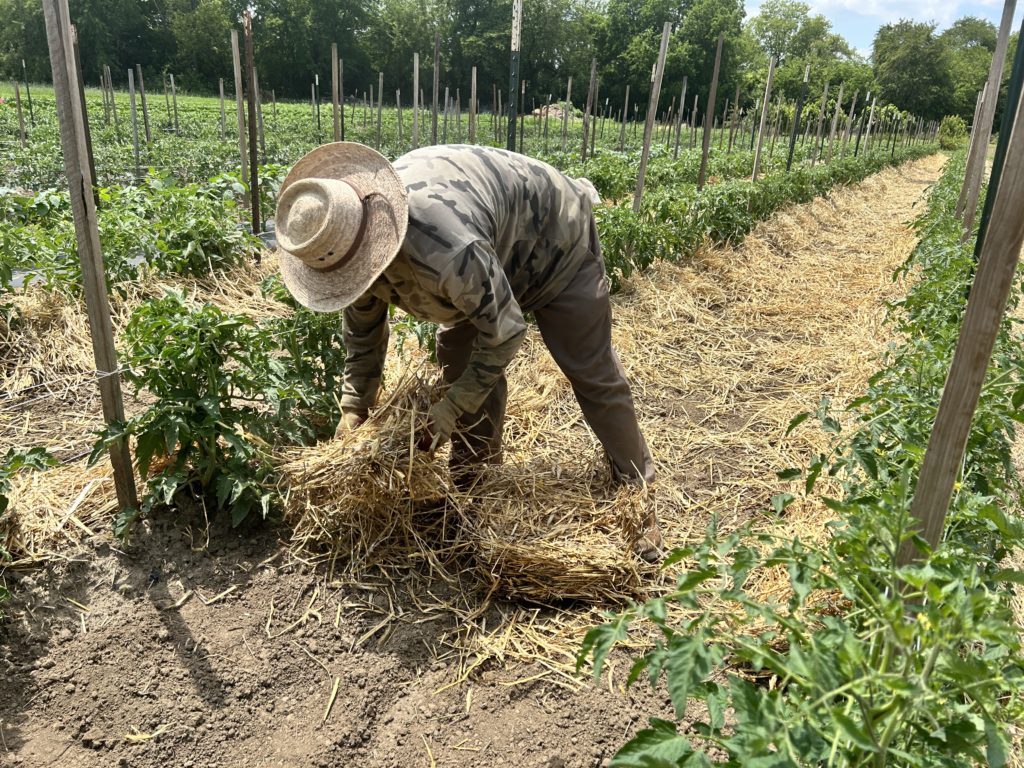
Polo lines the pathways between the tomato beds with straw mulch… an itchy job!
Speaking of wearing long sleeves, you may have noticed that my crew always wears long sleeves. Some people are surprised by this, as it is pretty hot out here, and you might think that we’d want to wear less clothing. The truth is that we stay cooler when we wear long sleeve, and we protect our skin from the damaging sun’s rays. A lot of the jobs involve working with weeds that may irritate the skin, so covering everything is recommended. I always encourage my guys to take breaks and drink lots of water. The break room is cool, and we have several volunteers who bring us Gatorade and frozen treats each week, to keep the staff freezer stocked. I call one of them “The Ice Cream Fairy.”
The big news this week was a garage fire broke out on Thursday. Noah called me while I was out in the field mulching the cucumbers. Apparently my dad had parked the mower in the garage and closed the door — and the grass caught underneath must have caught fire. John noticed the flames inside thru the glass as he was heading to his car for lunch break. He ran and opened the door, then ran inside to tell Corinna. She called 911, and the boys scrambled to find fire extinguishers from around the house and farm. Jed had the bright idea to use the water hose, which luckily stretched long enough to reach. Corinna said the flames were pretty high at one point, and we thought that our garage roof may have suffered some damage. Surprisingly, the only thing that was damaged was the mower itself. We were able to get it out just as the fire engine came into the drive. But it was a lesson for all of us on how quickly a fire can start. I’ll have to replace the mower — but that’s a small price to pay. We’re just glad that we caught it in time before it got out of control.

The sweet corn tassels sway in the wind and blow their pollen down below where it can fertilize the ears.
The first sweet corn is tasseling! We should have our first corn in about 3 weeks. This is always an exciting milestone in the season for us. Everyone LOVES Dad’s corn. Once that harvest begins, our mornings are dominated by sweet corn, and two of my guys will be dedicated to that job alone.
Did you have some fun for the Fourth of July? We were able to get away to our Turnow Family Reunion for a few hours. We have a big potluck and swim fest at my cousin’s house in Curtice. They have a pond with a high dive and dock, that my boys LOVE. Corinna’s brother Torsten came for a weekend visit, too. He is now living outside Chicago, at a model railroad company. It’s supposed to rain tomorrow, and I’m hoping I can get away for the day with the kids and Corinna to drive to Dayton to the airforce museum — that museum is still the best and biggest collection of planes I’ve seen anywhere in the USA.
Corinna and I have planned a week of vacation in July sometime. We will be making a decision as to WHEN specifically this will occur in the next week. It will either be the 3rd or 4th week of this month. When it happens, the CSA just “pauses” for a week, and resumes with the next week. “A” and “B” weeks resume as usual without skipping a beat. We’ll let you know when we have more details!
~Your Farmer, Kurt
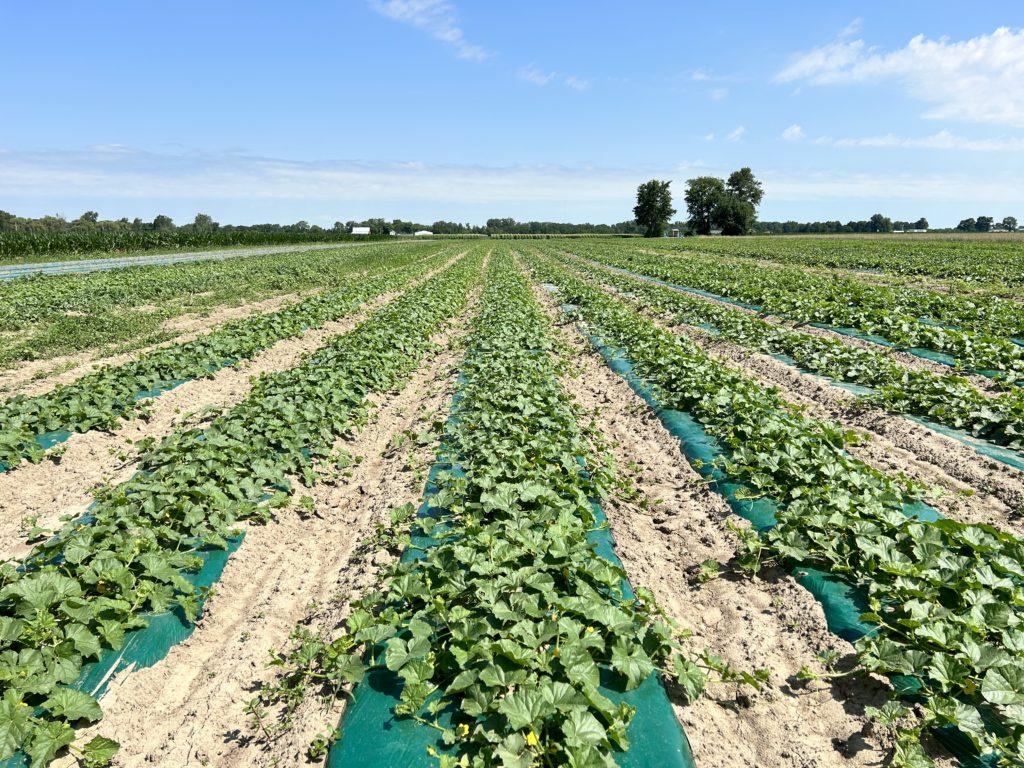
This is the second melon planting.
How We Keep a Steady Stream of Veggies Always Coming…
(Succession Planting 101)
I was walking the melon patch this week to take some pictures, and I noticed that my father-in-law had just transplanted a new patch of babies. These were juxtaposed right next to an acre of maturing melon vines that were well on their way to producing our first melons of the season.
I thought I would take this week to discuss this concept of “succession planting,” because before I met Farmer Kurt, it never occurred to me that farmers would have to orchestrate multiple seedings of a crop and time them so that the public food supply “never runs out.” Imagine going to David Bench’s roadside stand and trying to buy sweet corn, and they say, “We’re sold out! Our first patch is all used up! That patch will only hold for 2 weeks.” We’d have a mutiny. Of course, sweet corn can grow for more weeks in the year! But unless we plant a new batch every two weeks, we WOULD run out.
Succession planting is a practice where farmers deliberately stagger their plantings to ensure a continuous supply of fresh produce. By planting crops at different intervals, we can extend the growing season. This technique applies not only to sweet corn, but also melons, summer squash, carrots, cilantro, radishes, turnips, and lettuces..
Mother Nature can be unpredictable, with challenges like pests, diseases, and adverse weather conditions threatening crop success. (Ever notice how your cilantro always bolts and goes to seed on you after like 2 weeks!) Succession planting also acts as a safeguard, reducing the risk of losing an entire crop to a single event. If one planting is affected, other batches behind may thrive, offering a buffer against potential losses.

This is the 3rd melon succession planting. It’s much smaller and will be ready in later August.
Succession planting requires meticulous planning and organization. Kurt must create a planting schedule, considering factors like germination time, maturity period, and the desired length of the harvest season. A well-designed plan will help ensure a smooth transition between plantings, minimizing gaps and maximizing productivity.
A farmer also has to think about the effects of succession planting on soil health and fertility. Our first years of the CSA, we just kept putting new plantings right behind the old ones, reusing the soil over and over. Our soil got tired, and after a while, we began to notice the yields went way down, and the plants got sick. To support multiple plantings, maintaining soil health and fertility is crucial. We quickly learned we had to build in time to “rest” the soil and amend it. Now we consider things like organic matter enrichment, crop rotation, and proper nutrient management to prevent soil exhaustion to optimize plant growth.
Being a farmer isn’t just about knowing how to grow a plant from seed.. it’s also about understanding the timing of things, the wisdom that comes from many years of repetition, trial and error, and “riding the wave” that Mother Nature throws your way.
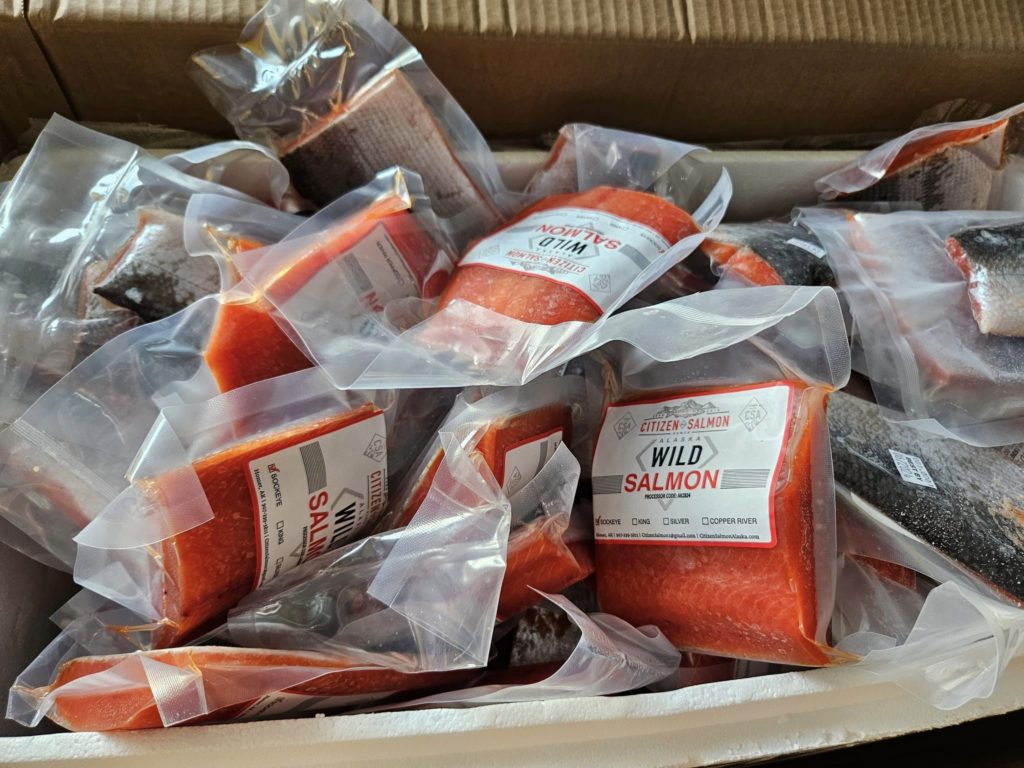
This is what 40 lb. of salmon looks like! Photo courtesy of Marisa Burkhardt
WEEK 4 ANNOUNCEMENTS
Your farmers are going on vacation soon! It may be next week, or the week after that! We will know VERY SOON! If we do, we’ll make sure you know about it. We will simply “pause” the 18 week CSA, and resume once we get back. If this affects any of our Sampler members, we will reach out to you and let you know what your new substitute date will be.
- This Month’s Bingo Contest is underway! Play SLFarms Bingo with us this month!
From July 1 – July 21, you are encouraged to compete in our SLF Bingo Board competition. Download this PDF file of our Bingo Board. Fill in as many of them as you can over the next 3 weeks! Some of them are EASY (you may already have done them), and some are little more challenging. Once you complete 20 of the 25 spots, post a picture of your Bingo board in our Facebook group with the hashtag #CSABingo2023, or send me an email that you’ve completed it. I’ll choose 2 random winners from this pool of submitted boards on July 22nd, and you’ll receive a box of baked goodies from the Occasional Baker! - Farm Dinner is June 29th! Read the article above for details. Or go to this link to pre-pay on Cork and Knife’s event page.
- Shop Our Online Store This Week for More Goodies: Our store link is super easy to remember: www.sharedlegacyfarms.com/store. Just be sure to select the right pickup site that coincides with your pickup location. If the pickup option is greyed out or not available, it means you missed the window to order. You need to place your order 36 hours before your site. We harvest the product on Monday and Wednesday mornings — early. This week, the store will have: carrots (no tops), white scallions, gooseberries, red currants, cherries, red beets, chioggia beets, dinosaur kale, curly kale, white or green kohlrabi, Rainbow chard, summer squash (yellow), Summer squash (patty pan), curly kale, garlic scapes, rye flour, SLF swag stickers, honey, and maple syrup.
- SALMON FROM CITIZENSALMONALASKA.COM is now shipping orders. Place your order for salmon, halibut, or scallops now at www.CitizenSalmonAlaska.com. You can order ANY time of year while supplies last. The fish is SUPER fresh — processed and blast-frozen within 5 hours of the catch. Aaron processes it into smaller cuts (individual portion sizes) and each portion is vacuum-sealed. It arrives frozen on your doorstep, or your money back. And you’ll get a notification from Aaron once it’s shipped so you can keep track of its progress.As a CSA member you get a 5% discount on ALL online orders with CitizenSalmonAlaska.com through December, 2023. Use the coupon code we gave you in your email. Note that the price of overnight FedEx shipping is included in the cost you see per pound on the website. You get a significant savings the more fish you buy. So a 40 lb. order of salmon will be much less than a 15 pound order.
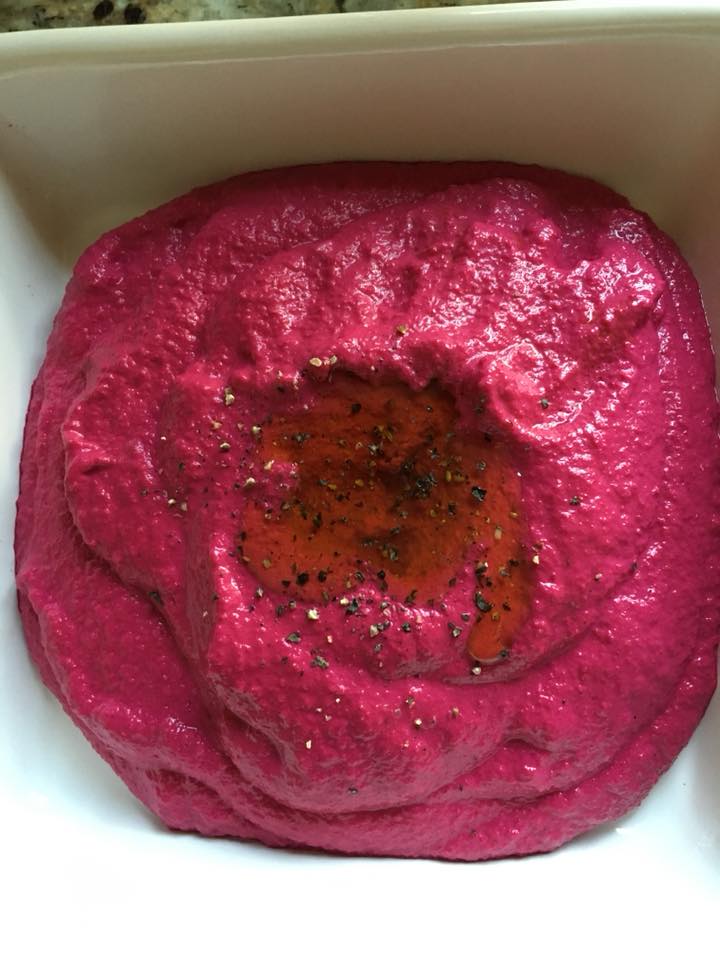
Don’t forget to try this beet hummus — always a popular dish with CSA members.
WEEK 4 CSA RECIPES
Members: You can download these recipes as a PDF here. These recipes are designed to inspire you to use your box this week! Please check inside our private Facebook group to find your fellow members sharing ideas for what to make with their box! Share a photo and you might be featured in next week’s newsletter!
Tropea Onion Jam
Spaghetti with Tropea Onions
Stir Fried Rice Noodles with Kohlrabi and Basil
Sauteed Kohlrabi, Onions and Basil
Miso Roasted Turnips
Beetroot and Feta Cheese Salad
Grated Beet Salad
Quick Pickled Beets and Onions
Microwaved Kale Chips
Sweet Potato and Kale Hash
Grilled Cabbage Caeser Salad
Kohlrabi Fries
Spicy Peanut Cabbage and Chard Salad
Parsley or Dill Garlic Butter
Chimichurri Sauce
Bibb Lettuce, Chicken, and Cherry Salad With Creamy Horseradish Dressing
Cherry Berry Crisp
Blueberry Muffins
Rhubarb Liqueur
Strawberry Rhubarb Crumble Bars

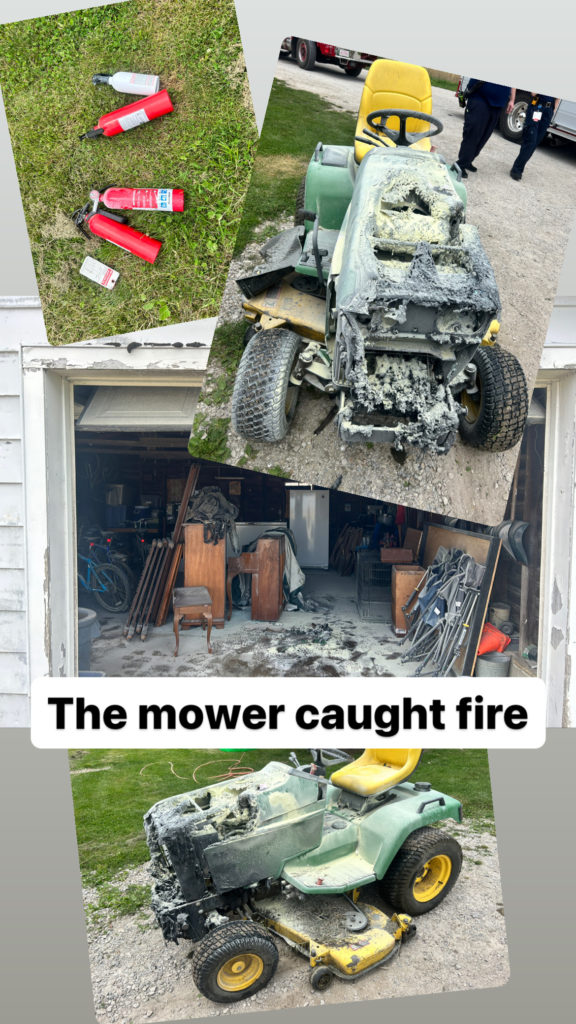
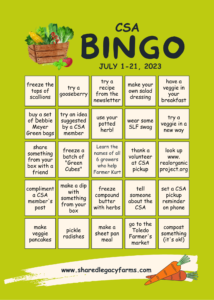 Your farmers are going on vacation soon! It may be next week, or the week after that! We will know VERY SOON! If we do, we’ll make sure you know about it. We will simply “pause” the 18 week CSA, and resume once we get back. If this affects any of our Sampler members, we will reach out to you and let you know what your new substitute date will be.
Your farmers are going on vacation soon! It may be next week, or the week after that! We will know VERY SOON! If we do, we’ll make sure you know about it. We will simply “pause” the 18 week CSA, and resume once we get back. If this affects any of our Sampler members, we will reach out to you and let you know what your new substitute date will be.